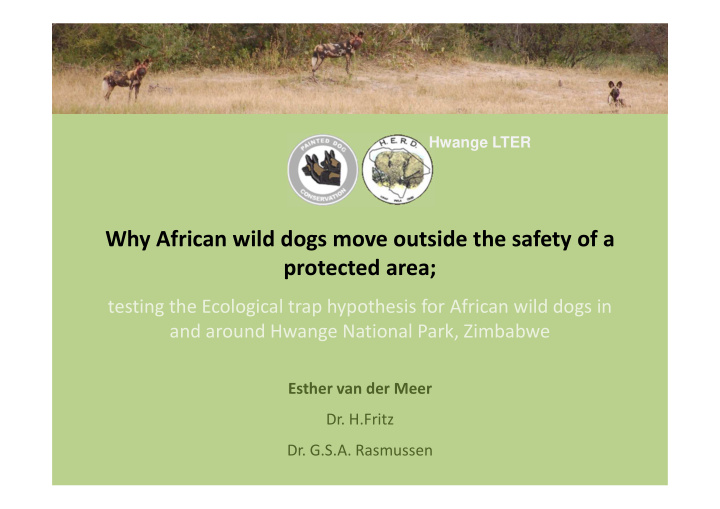



Hwange LTER Why African wild dogs move outside the safety of a protected area; testing the Ecological trap hypothesis for African wild dogs in and around Hwange National Park, Zimbabwe Esther van der Meer Dr. H.Fritz Dr. G.S.A. Rasmussen
____________________________________________________________ African wild dog Endangered social carnivore with large territories and high energetic requirements
____________________________________________________________ Territorial drift of African wild dog packs in Hwange National Park (HNP)
____________________________________________________________ Litter size in relation to distance of the territory to the Hwange National Parks (HNP) border
____________________________________________________________ Main causes of mortality inside and outside Hwange National Park (HNP) Snare Car Shot Lion and Starvation Natural Unknown Total Hyena Inside HNP % 0.0% 5.4% 0.0% 17.2% 12.9% 20.4% 44.1% 28.4% Nr 0 5 0 16 12 19 41 93 Outside HNP % 25.6% 12% 18.8% 3.9% 11.5% 9.8% 18.4% 71.6% Nr 60 28 44 9 27 23 43 234
____________________________________________________________ Average recruitment in relation to territory placement in, at the border or outside Hwange National Park (HNP) Location Pack Pups Mor Mor Immi Dis Pack Re territory size born tality tality gra per size cruit start pups ad/yy tion sal end ment Inside HNP Mean 4.94 4.11 2.06 0.50 0.00 0.50 6.00 1.06 (n=18) SE 0.57 0.74 0.49 0.17 0.00 0.29 0.84 0.49 Border Mean 4.97 4.88 2.55 1.48 0.39 1.21 5.00 0.03 (n=33) SE 0.42 0.71 0.44 0.37 0.24 0.32 0.51 0.56 Outside HNP Mean 5.23 7.23 4.54 2.54 0.23 2.00 3.62 -1.62 (n=13) SE 1.09 1.73 1.25 0.87 0.12 1.12 0.82 1.34 Total Mean 5.02 5.14 2.81 1.42 0.25 1.17 5.00 -0.02 (n=64) SE 0.34 0.56 0.38 0.27 0.13 0.29 0.40 0.43
____________________________________________________________ Why? Predator? Prey?
____________________________________________________________ Classic source sink system: Animals migrate into low quality sink habitat (mortality>natality) when there is not enough high quality source habitat (mortality<natality) available (sink) Ecological trap: Animals migrate into low quality sink habitat (mortality>natality) even when there is enough high quality source habitat (mortality<natality) available (attractive sink – unaccounted risks – Extirpation! )
____________________________________________________________ Prey availability Diet composition inside and outside Hwange National Park (HNP)
____________________________________________________________ Prey catchability Hunting success in and outside Hwange National Park (HNP) Inside HNP Outside HNP Success Failure Success Failure Overall % 50.81 49.19 63.03 36.97 Nr 63 61 104 61 Main prey % 59.46 40.54 78.89 21.11 Nr 44 30 71 19 Impala % 65.00 35.00 86.92 23.08 Nr 26 14 30 9 Kudu % 44.83 55.17 84.38 15.63 Nr 13 16 27 5
____________________________________________________________ Prey catchability Chase distance in and outside Hwange National Park (HNP) Chase dist (km) Inside HNP Outside HNP Overall 1.09 (n=35, SE=0.18) 0.87 (n=68, SE=0.13) Main prey 1.40 (n=24, SE=0.22) 0.91 (n=45, SE=0.17) Impala 1.28 (n=11, SE=0.23) 1.05 (n=17, SE=0.21)) Kudu 1.79 (n=10, SE=0.44) 1.14 (n=17, SE=0.37) Duiker 0.55 (n=3, SE=0.24) 0.33 (n=11, SE=0.08)
____________________________________________________________ Prey catchability Vegetation types in which African wild dogs made impala (n=41) and kudu (n=35) kills inside and outside Hwange National Park (HNP) Available vegetation in and outside Hwange National Park (HNP) based on random sites (n=148)
____________________________________________________________ Predator competition Presence of, and kleptoparasitism by lion and hyena inside and outside Hwange National Park (HNP) Lion and/or Hyena Inside HNP Outside HNP Presence 16,23% (n=31) 5.65% (n=17) Kleptoparasitized 9.42% (n=18) 2.66% (n=8) Defended 6.80% (n=13) 2.99% (n=9) Mean lapse time (min) ± SE 11.33 ± 2.57 18.80 ± 4.32
____________________________________________________________ Does the Hwange system serve as an ecological trap? Ecological trap = attractive sink = animals choose to be in habitat in which mortality exceeds natality This choice is based on formerly reliable cues that are no longer associated with an adaptive outcome due to a sudden environmental change Criteria to identify an Ecological trap ( Robertson & Hutto 2006 ): 1) Preference or equal preference for one habitat over the other 2) Measure to allow idenitification of fitness differences 3) Fitness outcome in preferred habitat should be lower
____________________________________________________________
____________________________________________________________ Thank you for your attention!
Recommend
More recommend